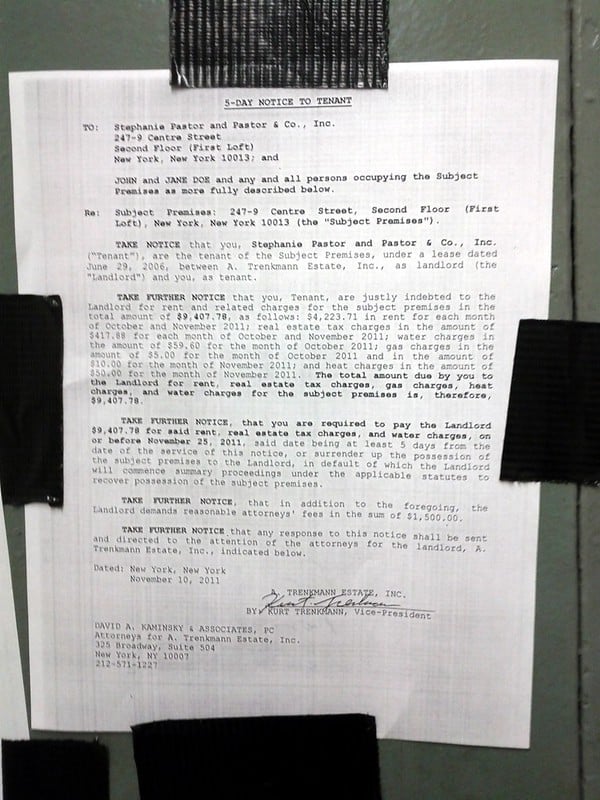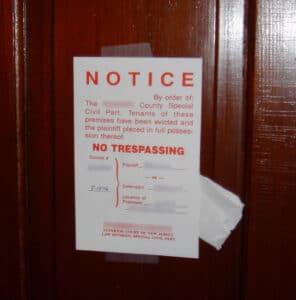Landlords often have to send a Letter of Notice when a tenant violates their lease due to non-payment of rent or other contractual violations, or the landlord needs to terminate the agreement at no fault of the renter.
In many cases, the letter is a requirement necessary to take legal action to formally evict a tenant and recover any damage to the property.
Whether you have a robust portfolio of investment properties or are just starting, understanding the legal requirements for notifying tenants of lease changes, termination, and violations is crucial. In this guide, you will learn how, when, and why you need to address tenants in a formal format.
You will also learn how to send your notice and record the communication, so its validity is not questioned in future legal proceedings.
A landlord's notice to vacate is a letter telling a tenant they must leave the property or face further action to remove them legally. The notice to quit is one of the first steps in the eviction process.
Each state has laws that dictate what information has to be in the letter and how the landlord must serve it.
The Federal CARES Act, enacted on July 24, 2020, requires a 30-day notice period for properties and people covered under the new law. The CARES Act took effect after a 120 mortgage moratorium that prevented landlord's from evicting tenants or filing eviction lawsuits.
The 30-day period provided to tenants helps to combat homelessness by giving people enough time to secure other housing before losing their current housing. It also gives the occupants a more extended period than allowed under most state laws to vacate and avoid an eviction which has devastating effects on consumer credit reports.
A 30-day Notice to Vacate is now required for all properties financed by a federally backed loan or a federally funded multifamily mortgage loan. Federally backed loans are secured by a first or second lien that is:
The CARES Act makes this a requirement for 1-4 family homes and multifamily housing complexes that fit the above criteria. While there is currently a 30-day notice requirement for these loan types, the laws changed several times over the past few years in response to the COVID-19 pandemic, and there may be additional changes in the future. So, it is essential to check the current laws governing notice periods.
When the tenant protection regulations set forth under the CARE Act are not in place, the notice periods default to the governing laws independent of the state. In some cases, states even waive the notice of termination requirements.
However, minimal situations allow landlords to demand a legal occupant to vacate the property without at least a three-day grace period.
For conventionally financed properties, a landlord can terminate a lease in the timeframe dictated by state laws. However, they still have to provide the proper documentation and, in some states, cause to evict the tenant.
If you terminate the lease for cause, you must include the reason in the Letter of Notice to Vacate. Be sure to include details like offense dates, the alleged lease violation, and a reference to any other breaches. The notice should also include any measures the tenant can take to remedy the lease and avoid eviction.
It is common courtesy to give a tenant at least thirty days' notice if you are terminating the lease without cause. However, some states require 60 to 90 days' notice of lease termination without reason, and others restrict the termination of a lease without cause unless the lease indicates that the landlord reserves that right.
The laws that govern the termination of leases are known as landlord-tenant laws. Each state has a set of these statutes that apply to residential and commercial property leased or rented. In states that restrict lease termination for the term, landlords may have to buy out the tenant if they want to end the contract early.
Writing a letter of notice to a tenant is nothing you should fear. It is as simple as drafting a letter that outlines any lease violations or changes to the contract. However, if any of the vital information is excluded, the notice may not suffice the legal requirement necessary to take further action to remove a tenant legally.
One of the most critical components of a letter of notice to a tenant is the notice period length. A judge may dismiss a subsequent eviction lawsuit if you give too little information. In that case, you would have to repost the notice with the correct notice period before refiling.
That might not be as critical in areas with a short notice period. However, if there is a 60-day requirement and you give 30 days before filing, the judge would make you repost the notice and wait an additional 60 days before hearing your eviction case.
All tenant notices should include the date. However, you need to post the notice on that day because the notice period does not start until the tenant receives the correspondence unless you are in a state that allows delivery by mail.
For documentation purposes, you need to reference the property address. Inclusion of the address is essential if you have to pursue legal action to remove the tenant.
All formal communications should start with a salutation. The salutation should be proper and include the leaseholder's name as it appears on the rental agreement.
The introduction should outline the reason for the notice and reference the associated clause in the tenant's lease agreement or local laws that warrants the letter. If there is no clause in the lease, reference the landlord-tenant laws that govern the violation in your local jurisdiction.
The body of the letter should give details as to the nature of the offense. If there is any evidence to support the violation, include that information, too. You also need to let the tenant know how the renter can remedy the situation and remain in the home or the date by which you expect them to vacate.
Conclude the letter by telling the tenant the date on which you will take further steps to have them removed and your intended next steps, which in most cases is the filing of an official eviction lawsuit.
In most cases, letters have to be signed to have legal validity. So, it is always good practice to sign written correspondence, especially when it is pertinent to a legal agreement.
You need to include your contact information so the tenant can contact you if they need to. Some landlord-tenant disputes are quickly resolved through communication. Sometimes, a landlord receives incorrect information, or the steps for remedying the lease are unclear. In those cases, it is critical for the tenant to have access to speak with the landlord.
A lease agreement is a legally binding agreement. So, all communication regarding the agreement has to be formal and documented.
The Notice of Lease Violation below is a great example of the information most letters include.

Aside from the contractual obligations to provide notices to tenants, each state has landlord-tenant laws property owners must follow. If you fail to provide the proper warnings or timeframes, a judge could throw out your eviction case, and in some situations, the tenant may be able to countersue.
Most leases give the tenant a three-day grace period to submit rent payments after the first of the month. When a tenant does not send their rent payment before the timeframe outlined in the rental agreement, landlords typically send a formal notice telling the tenant the payment is late. The letter usually includes the amount of the current balance and any further action the landlord will take if the tenant does not pay promptly.
The term 'Eviction Notice' is a bit deceiving. It almost implies that the tenant has already been evicted and needs to leave the property. On the contrary, an Eviction Notice can be given at any time during the process to update the tenant of any new action taken against them.
A Notice to Vacate is usually the document used when a landlord first notifies a tenant that they violated their lease. These are also referred to in some cases as a Notice to Pay or Quit or a Notice to Remedy or Quit. However, the Notice to Vacate is used interchangeably.
The Notice to Vacate can mean that the landlord or law gives the tenant time to correct the lease, or it could be a formal request from the owner asking the tenant to vacate without an option to remain on the property.
Each state has different laws that govern the amount of notice a landlord has to give a tenant before they can file a legal eviction. In Texas, the requirement is a three-day notice to vacate.
If the tenant moves out during the three days, they can avoid an eviction, which makes it very challenging to rent another property. In other states, the notice length varies from three to thirty days.
Sometimes a landlord must terminate a lease for reasons other than non-payment. One of those times is when the property owner is selling their home.
Timeframes for notices to vacate when the landlord is terminating at no fault of the tenant depending on the rental agreement signed by the parties. Some leases require landlords to give 30 to 60 days, and others need the landlord to buy out the tenant and even pay for moving expenses.
When people use the term eviction notice relating to unpaid rent, they typically refer to a vacate notice. If a tenant has not paid the agreed-upon monthly rent by the date specified in the agreement, the landlord has to notify the tenant that they are violating the lease and what action the landlord plans to take.
When tenants plan to move out, they must notify the landlord in writing. Some lease agreements require notice 30 days before the lease agreement ends. Otherwise, the landlord can automatically renew the lease on a month-to-month basis, and they can increase the rent to compete with current market rent prices.
So, as a tenant, it is essential to provide a written notice documenting your intention to vacate the property at the end of your term. It is good practice to submit the letter the month before the last month covered in your lease when you submit your rent payment.
You may also want to confirm that the landlord received the notice. Any written communication will work to protect you from being charged for an additional month at the end of your term.
In California and several other states that require a 60-day notice length before allowing the property owner to file an eviction, renters in government-subsidized housing have to be given a 90-day notice period.
In most areas, property owners must notify renters before they access the premises unless it is an emergency. Landlord-tenant laws in some states restrict a landlord from entering their property without the tenant's permission.
The states that have laws restricting a property owner's right to access during the lease period include:
In these states, when the landlord needs access at a time other than those covered in the lease, they have to wait for the tenant to allow them access or obtain a court order. In non-emergencies, the owner should approach the tenant professionally and try to make arrangements for admission at a convenient time for both. The notice needs to outline the following:
In emergencies, landlords are given the right to immediate access if:
If the landlord enters the home for an emergency, they should notify the tenant as soon as possible and outline why access was necessary and what they did in the unit.
Landlord-tenant laws in some states require landlords to give 30, 60, or even 90 days' notice under certain circumstances.
A 5-Day Notice of Lease Violation is the requirement in some states. The five-day period allows tenants a few extra days to move out or remedy the infractions before the owner takes further judicial action.

The states with a five-day requirement include:
Like other violation notices, a 5-Day Notice to Vacate must include:
Landlords use a Notice to Vacate for a few reasons. The renter has either violated their lease agreement, or the landlord is seeking to terminate at no fault of the tenant. All vacate notices must follow the signed lease contract or local statutes when the agreement does not explicitly address the matter.
In theory, a Notice to Pay or Quit should be used when the landlord or lease allows the tenant to resolve the infraction. If the leaseholder has no remedy options, the landlord should use a Notice to Vacate. However, these documents are used interchangeably.
Courts typically are less interested in the document's title when it comes to landlord-tenant matters and more concerned with the content.
A Notice to Vacate is not the same thing as an eviction. However, it may be used interchangeably with the term, 'Eviction Notice.'

A Notice to Vacate is the first step in an eviction process. In most areas and situations, the notice to vacate starts the clock for the period the landlord must give the tenant before filing to initiate a formal eviction.
The timeframe for giving the Notice to Vacate depends on whether you are the landlord or tenant. Suppose you are the tenant. The time you have to give notice depends on the Notice to Vacate clause in your rental agreement.
If there are local laws that allow tenants to break their lease early, the notice must be given to the landlord within the timeframe outlined. Some cases that fall under federal or local law protection provide the tenant the right to move out without notice. Some of the situations that allow the tenant to terminate the lease immediately include:
Letters of notice are fairly simple to draft and manage if you know the components they must include and the period the law requires you to give the tenant to vacate before you file an eviction lawsuit.

However, it also helps to know the answers to other landlords' questions about these legal letters.
Notice letters are relatively straightforward. Unless the tenant has numerous violations, the letter should only take a few minutes to write. There are also resources for quickly creating legal property documents. These programs use fillable forms to make drafting the letter very simple.
Asking a tenant to leave their home is one of the more challenging things for some landlords to do. However, there is no getting around the task.
So, you will want to write a letter that gives the details regarding the lease termination, whether it is with or without cause, clauses in the lease agreement that relate, and how the leaseholder can contact the landlord if they have questions.
The best way to ask a tenant to leave your property nicely is to be straightforward and honest. Try putting yourself in their position before communicating with the tenant. That way, you will become more compassionate and relatable, which always helps when you have to bring up a complex subject.
Drafting a Letter of Notice to a tenant is one of the easier things you may do as a rental property owner. The notice does not have to be long, but it does need to contain the information required by law in your jurisdiction and follow statutes governing timeframes.
If you are unsure how to properly draft these vital communications, hiring a management company or real estate attorney that handles these matters can help you avoid costly eviction court delays due to an improperly drafted or posted letter of notice to a tenant.
We encourage you to share this article on Twitter and Facebook. Just click those two links - you'll see why.
It's important to share the news to spread the truth. Most people won't.